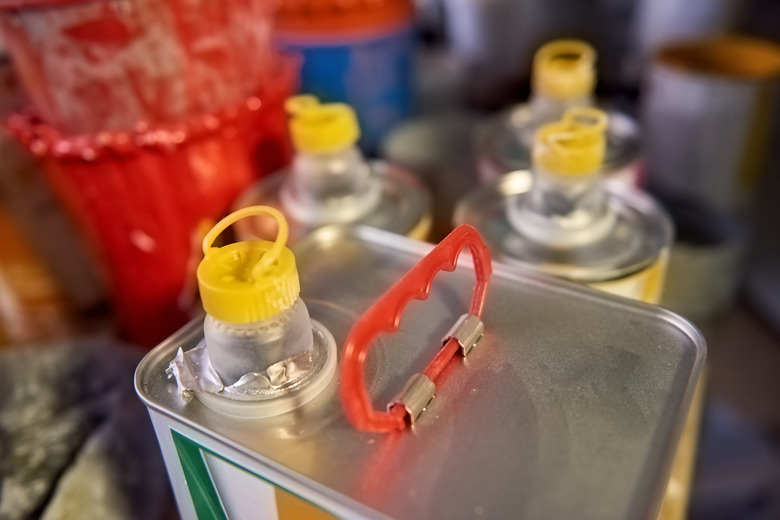Difference Between Paint Thinner & Lacquer Thinner
We may receive a commission on purchases made from links.
Acrylic latex paint, with its low concentration of volatile organic compounds (VOCs), has become the number one interior paint. And since that's a water-based paint, you thin it with water. But oil-based paints are still in common use for painting exterior surfaces and even interior trim, and lacquer is still the preferred coating for furniture and cabinets. If you use either of these finishes, you need an appropriate solvent, and paint thinner and lacquer thinner aren't the same.
Although the two solvents are different, they both come from the same source: petroleum. The chemicals in lacquer thinner are derived at a different stage in the refining process than those in paint thinner. Both chemicals are noxious, and you should wear a respirator when working with either of them.
Paint Thinner
- Higher vapor point
- Feels oily to the touch
- Best for thinning oil-based paint
Lacquer Thinner
- More volatile hydrocarbons
- Feels light and cool to the touch
- Best for thinning lacquer
Lacquer Thinner Is Richer in Volatile Hydrocarbons
Lacquer Thinner Is Richer in Volatile Hydrocarbons
The process of refining crude oil to produce gasoline, kerosene, and other fuels also yields a number of other products, including solvents. Crude is a mixture of hydrocarbon chains of various lengths and structures with unique boiling points. To separate these out, refiners boil the crude and pass the vapors through distillation tubes in a procedure known as fractional distillation.
The longer, heavier chains have high boiling points and are the first to settle out while shorter, lighter chains remain in the vapor state. Diesel, jet fuel, and gasoline are composed of medium-length molecules that settle out midway during the process, while solvents remain until the end.
Solvents like lacquer thinner and paint thinner are flammable and odorous. Of the two, lacquer thinner is the more volatile and flammable because it contains a higher concentration of light molecules that vaporize easily.
Chemical Composition of Paint Thinner and Lacquer Thinner
Chemical Composition of Paint Thinner and Lacquer Thinner
Various formulations of paint thinner exist, but most include Stoddard solvent, which is a particular type of mineral spirits. Also known as white spirits, Stoddard solvent typically contains mid-range hydrocarbons, but the actual composition varies according to the distillation process. Because the molecules that compose it are moderately heavy, paint thinner usually has a somewhat oily texture.
You can also find a variety of formulations of lacquer thinner in paint stores. Most contain toluene, xylene, acetone and methyl ethyl ketone, which are lighter than the molecules that comprise Stoddard solvent. Lacquer thinner feels light to the touch, and because it vaporizes quickly, it makes your finger feel cold. It's used almost exclusively to thin coatings that dry by evaporation, such as lacquer.
Mineral Spirits vs. Paint Thinner
Mineral Spirits vs. Paint Thinner
Mineral spirits and paint thinner are almost the same, except that mineral spirits is more highly refined and has less odor. You can use either product to thin oil-based paint and to clean up after painting.
The higher vapor point of paint thinner actually gives it an advantage over lacquer thinner. Because it doesn't evaporate as quickly, it gives the paint time to level out, which reduces the chances of cracking. The slower evaporation rate also gives you more time to apply the paint.
Among the other paint thinner uses are reducing paint to make it suitable for spraying and preserving open cans of oil-based paint by covering the paint with a layer of the solvent.
When to Use Lacquer Thinner
When to Use Lacquer Thinner
Lacquer thinner is the only solvent you should use when spraying lacquer. The chemicals in lacquer thinner dissolve the resins more easily than paint thinner, which doesn't mix well with lacquer at all. The chemicals also dissolve grease and oil more readily than paint thinner, making lacquer thinner a better choice for cleaning tools, auto parts and other metal machine components.
Warning
Make sure to always read the label before using lacquer thinner to ensure you don't damage anything it may not be compatible with.
